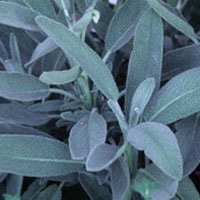
A-Z Indexes Food Health Guides
Health News |
SageFind ProductsAlso indexed as:Salvia officinalis  © Steven Foster © Steven FosterBotanical names: Salvia officinalisParts Used & Where GrownSage is a silvery-green shrub with very fragrant leaves. The most commonly cultivated species of sage originally came from the area around the Mediterranean but now also grows in North America. The leaves of this common kitchen herb are used in medicine as well as in cooking.1
Our proprietary “Star-Rating” system was developed to help you easily understand the amount of scientific support behind each supplement in relation to a specific health condition. While there is no way to predict whether a vitamin, mineral, or herb will successfully treat or prevent associated health conditions, our unique ratings tell you how well these supplements are understood by the medical community, and whether studies have found them to be effective for other people. For over a decade, our team has combed through thousands of research articles published in reputable journals. To help you make educated decisions, and to better understand controversial or confusing supplements, our medical experts have digested the science into these three easy-to-follow ratings. We hope this provides you with a helpful resource to make informed decisions towards your health and well-being. This supplement has been used in connection with the following health conditions:
Traditional Use (May Not Be Supported by Scientific Studies)Sage has one of the longest histories of use of any culinary or medicinal herb. It was used by herbalists externally to treat sprains, swelling, ulcers, and bleeding.2 Internally, a tea made from sage leaves has had a long history of use to treat sore throats and coughs—often used as a gargle. It was also used by herbalists for rheumatism, excessive menstrual bleeding, and to dry up a mother’s milk when nursing was stopped. It was particularly noted for strengthening the nervous system, improving memory, and sharpening the senses.3 Sage was officially listed in the United States Pharmacopoeia from 1840 to 1900. Copyright © 2025 TraceGains, Inc. All rights reserved. Learn more about TraceGains, the company. The information presented by TraceGains is for informational purposes only. It is based on scientific studies (human, animal, or in vitro), clinical experience, or traditional usage as cited in each article. The results reported may not necessarily occur in all individuals. Self-treatment is not recommended for life-threatening conditions that require medical treatment under a doctor's care. For many of the conditions discussed, treatment with prescription or over the counter medication is also available. Consult your doctor, practitioner, and/or pharmacist for any health problem and before using any supplements or before making any changes in prescribed medications. Information expires December 2025. |
